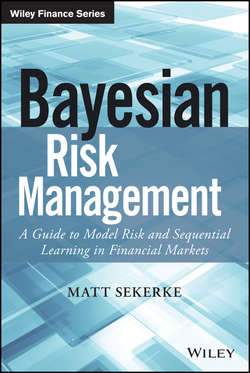Читать книгу Bayesian Risk Management - Sekerke Matt - Страница 5
Acknowledgments
ОглавлениеIt is hard to express my gratitude to Nick Polson adequately. Certainly, this book would not exist without him. His intellectual fingerprints are all over it, and I hope I have proven myself a worthy student. More than any lecture or guidance in the thicket of the statistical literature, the many hours spent with Nick (more often than not, over burgers at Medici on 57th in Hyde Park) thinking through the ways in which people attempt to learn about financial markets from data helped me not only to grasp the Bayesian manner of thinking about probability but also to gain the confidence necessary to test it against the prevailing orthodoxy. His intuitive way of proceeding and his fantastic sense of humor also made it great fun to set off in an exciting new field. For all I have absorbed from him, I am still overwhelmed by the many brilliant new directions of his thinking, and will have much to learn from him for many years to come.
This book also bears traces of many years working with Steve Hanke, first as his research assistant and as an ongoing collaborator in writing and consulting. Professor Hanke first introduced me to the importance of time and uncertainty in economic analysis by encouraging me to read the Austrians, and especially Hayek. These pages are part of an ongoing process of coming to grips with the wealth of ideas to which Professor Hanke exposed me. Professor Hanke has also supported my writing efforts from the very beginning and continues to be a source of encouragement and wise counsel to me in virtually all matters of importance.
Chris Culp has been incredibly supportive to me for nearly 15 years as a mentor and a colleague. His boundless productive energy and generosity of spirit have been an inspiration to me from the beginning. (“Ask Culp” was one of the more common prescriptions heard in Professor Hanke's office.) The insightful ways in which Chris connects problems in risk management with fundamental problems in economics and corporate finance were decisive in sparking my interest in the subject. More directly, without his introduction to Bill Falloon at Wiley, this project would have remained in the realm of wishful thinking.
Bill Falloon has shown me a staggering degree of support with this book and more generally in developing as an author. I look forward to more projects with him and his fantastic team, especially Meg Freeborn, who kept my developing manuscript on the rails despite multiple interruptions and radical, wholesale revisions.
Most important, I am grateful for the unflagging support of my incredible wife, Nancy. She kept me going on this project whenever the going got tough, and patiently auditioned my many attempts to distill my thesis to a simple and forthright message. Whatever clarity may be found in a book dense with mathematics and quantitative finance is probably due to her. All of the shortcomings of the book are, however, mine alone.
